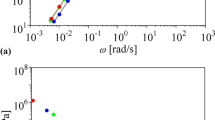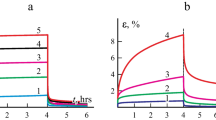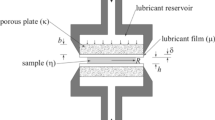Summary
Shear creep and constrained elastic recovery experiments on a well characterized low-density polyethylene melt are reported. The temperature dependence of the shear strain and the primary normal stress difference is discussed in detail. Comparison is made with predictions of a strain-dependent single integral constitutive equation, which has already been successfully used for the same polymer melt to describe the stress growth after sudden imposition of a constant shear rate flow and stress relaxation after cessation of steady shear flow. It should be emphasized that this constitutive equation contains no adjustable parameters. The linear-viscoelastic part of the memory function is related to the linear-viscoelastic relaxation spectrum, while the nonlinear, strain-dependent part was determined from rapid-strain experiments.
In the case of a prescribed shear stress history the resulting integral equation cannot be solved by closed integration but has to be inverted by numerical methods. Agreement between theoretical predictions and experimental data is rather encouraging for shear strain and primary normal stress difference during creep and retardation tests. Within experimental error, the strain and shear rate dependence of the recoverable portion of the total strain can be correctly predicted.
Zusammenfassung
Es wird über Kriech- und Retardationsversuche an einer bekannten Polyäthylen-Schmelze niedriger Dichte berichtet, die mit Hilfe eines Weissenberg-Rheogoniometers durchgeführt wurden. Die Temperaturabhängigkeit der Scherdeformation und der 1. Normalspannungsdifferenz wird diskutiert. Die Ergebnisse der Messungen werden mit den Voraussagen einer rheologischen Zustandsgleichung in Integralform verglichen, die, wie bereits früher für die gleiche Schmelze gezeigt wurde, das Anlaufverhalten beim Anlegen einer konstanten Schergeschwindigkeit und das Relaxationsverhalten nach Beendigung einer stationären Scherströmung richtig beschreibt. Dabei muß betont werden, daß diese Zustandsgleichung keine anpassungsfähigen Parameter enthält. Der linear-viskoelastische Teil der Gedächtnisfunktion hängt mit dem linear-viskoelastischen Relaxationsspektrum zusammen, während der nicht-lineare, deformationsabhängige Teil mit Hilfe von „rapid-strain“-Experimenten bestimmt wurde.
Schreibt man, wie bei Kriech- und Retardationsexperimenten, die Spannungsgeschichte vor, so kann die Zustandsgleichung nicht geschlossen gelöst werden, sondern muß mit numerischen Methoden invertiert werden. Die Übereinstimmung zwischen den berechneten und den gemessenen Werten der Scherdeformation und der 1. Normalspannungsdifferenz bei Kriech- und Erholungsversuchen ist recht zufriedenstellend. Innerhalb der experimentellen Fehlergrenzen läßt sich auch die Abhängigkeit der reversiblen Scherung von der Scherdeformation und der Schergeschwindigkeit berechnen.
Similar content being viewed by others
References
Laun, H. M. Rheol. Acta17, 1 (1978).
Wagner, M. H. Rheol. Acta15, 136 (1976).
Meissner, J. J. Appl. Polymer Sci.16, 2877 (1972).
Meissner, J. Rheol. Acta14, 201 (1975).
Meissner, J. Rheol. Acta10, 230 (1971),
Meissner, J. Trans. Soc. Rheol.16, 405 (1972).
Walters, K., Rheometry (London 1975).
Gleissle, W. Rheol. Acta15, 305 (1976).
Meissner, J., in:G. Schreyer, Konstruieren mit Kunststoffen (München 1972).
Giesekus, H., Proc. Fourth Int. Congr. Rheol., Providence, R. I., 1963, Part 3, 15 (New York 1965).
Meissner, J. Rheol. Acta14, 471 (1975).
Chang, H., A. S. Lodge Rheol. Acta11, 127 (1972).
Lodge, A. S., J. Meissner Rheol. Acta12, 41 (1973).
Wagner, M. H. Rheol. Acta15, 133 (1976).
Gortemaker, F. H., H. Janeschitz-Kriegl, K. te Nijenhuis Rheol. Acta15, 487 (1976).
Lodge, A. S. Elastic Liquids (Academic Press, London-New York 1964).
Lodge, A. S. Rheol. Acta7, 379 (1968).
Lodge, A. S. Body Tensor Fields in Continuum Mechanics (Academic Press, London-New York 1974).
Bernstein, B., E. A. Kearsley, L. J. Zapas Trans. Soc. Rheol.7, 391 (1963); J. Res. Natl. Bur. Std.68B, 103 (1964).
Kaye, A., College of Aeronautics, Note No. 134 (Cransfield 1962).
Tanner, R. I., G. Williams Trans. Soc. Rheol.14, 19 (1970).
Chen, I.-J., D. C. Bogue Trans. Soc. Rheol.16, 59 (1972).
Yen, H.-Ch., L. V. McIntire Trans. Soc. Rheol.18, 495 (1974).
Nazem, F., M. G. Hansen J. Appl. Polymer Sci.20, 1355 (1976).
Wagner, M. H. Rheol. Acta16, 43 (1977).
Wagner, M. H., Proc. VIIth Int. Congr. Rheol., Gothenburg, Sweden, 1976, p. 217.
Author information
Authors and Affiliations
Additional information
With 5 figures and 4 tables
Rights and permissions
About this article
Cite this article
Wagner, M.H., Laun, H.M. Nonlinear shear creep and constrained elastic recovery of a LDPE melt. Rheol Acta 17, 138–148 (1978). https://doi.org/10.1007/BF01517704
Received:
Issue Date:
DOI: https://doi.org/10.1007/BF01517704




